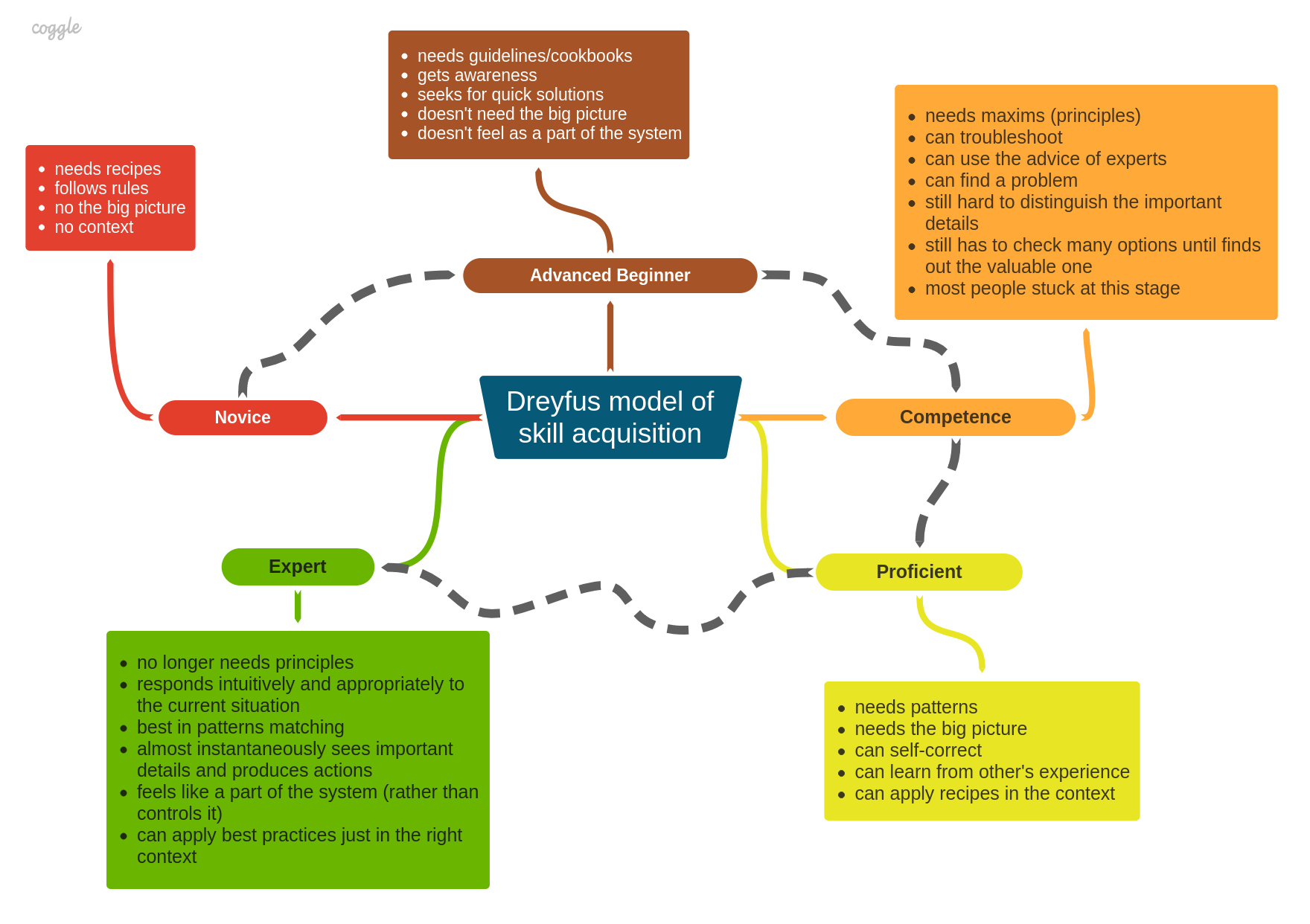Dreyfus model of skill acquisition
The power of the human mind over the reasoning machines
TLDR: quick summary of the article
There is a special term to describe the intelligence of computers that actually mimics human intelligence only to a certain extent. It is called Artificial Intelligence (AI) to emphasize its synthetic nature. Going back to 1980, the U.S. military had been supporting AI research for more than 20 years, and it was time to ask why almost all efforts to build AI systems capable of "providing expert medical advice, exhibiting common sense, and functioning autonomously in critical military situations" had failed.
In February 1980, the Dreyfus brothers (Stuart E. and Hubert L.) presented their report on the research conducted at the University of California, Berkeley with the support of the US Air Force Office of Scientific Research - "A Five-Stage Model of the Mental Activities Involved in Directed Skill Acquisition". This model shows how humans acquire new skills through instruction and experience. After the publication, they continued to work on the model and with some modifications and extensions, the results were published in their book "Mind over Machine. The Power of Human Intuition and Expertise in the Era of the Computer" in 1986. As the brothers said in the book, "our intention is more modest, but more fundamental": "what we can reasonably expect from computer intelligence".
A process of skill acquisition typically goes through five developmental stages (novice, advanced beginner, competent, proficient, expert). Each stage characterizes a particular behavior and mental response to a situation. A successful transition from one stage to another is associated with the appropriate transformation of four mental functions: recall, recognition, decision, awareness. Understanding the stages of development is essential for any skill training procedure to facilitate the process of acquiring new skills and advancing to the next stage. For human beings, the entire journey from novice to expert usually takes an average of 10 years. Or, more realistically, 10,000 hours of learning and practice. Some research has also shown that there are only up to 5% of experts on the planet, regardless of their field of expertise.
The report also pointed out that "as the student becomes more skilled, he depends less on abstract principles and more on concrete experience" and that only "skill in its minimal form is produced by following abstract formal rules". Thus, the higher levels of performance depend on "everyday, concrete, experience in problem solving". By gaining experience, a student is able to start from scratch by following rules of action in context-free situations. Then, after gaining some experience, a student is able to use guidelines for responding to situational aspects. Further practice leads to being able to use maxims (principles) to determine an appropriate action. All of these three transformations correspond to the first three stages and always represent some kind of analytical decision-making process that is needed to "connect his understanding of the general situation with a specific action".
The significant change occurs at Stage 4, when the number of "experienced situations is so vast that normally each specific situation immediately dictates an intuitively appropriate action". The key point here is the shift "from analytical thinking to intuitive response". The highest level of expertise with masterful performance occurs only when the expert "no longer needs principles" and is able to "move almost instantaneously into the production of the appropriate perspective and its associated action". This is one of the most important observations: experts perform beyond the rules, and their performance degrades significantly when they are constrained by any kind of formal rules or processes. In 2008 the Pragmatic Bookshelf published an excellent book "Pragmatic Thinking and Learning" by Andy Hunt. It gives a lot of insight into the human brain and how it works, a number of tips on how to learn more and faster, including a detailed review of the Dreyfus model (ch.2). I also created mind maps for the entire book.
Understanding the difference between the human mind and how a reasoning machine "thinks" helps to set realistic expectations for the development of artificial intelligence systems. In trying to define what computers should do, it is first necessary to be clear about what computers can do. In this regard, the computer is an analytical engine, so it can apply rules and make logical inferences. Of course, it does this with extreme speed, high accuracy, and remarkable reproducibility, but it still follows a certain logic. It turns out that precisely this crucial difference between a reasoning machine, which is perhaps perpetually limited, and the intuitive expertise of the human mind, which cannot be reduced to rules, seems to be a good starting point for finding the balance between humans and computers.

Summary
- The Dreyfus model describes how humans acquire new skills through 5 developmental stages: novice, advanced beginner, competent, proficient, and expert.
- The transition between stages involves transformations in mental functions like recall, recognition, decision-making, and awareness.
- Acquiring expertise typically takes around 10 years or 10,000 hours of learning and practice, with only 5% of people reaching the expert level.
- As people gain experience, they rely less on abstract principles and more on concrete, real-world problem solving.
- Analytical decision-making dominates the first 3 stages, but at the proficient and expert levels, intuitive responses become more important.
- Experts can perform beyond formal rules and their performance degrades when constrained by rigid processes.
- Computers are analytical engines that can apply rules and make logical inferences, but they lack the intuitive expertise of the human mind.
- Understanding the differences between human and machine intelligence is crucial for setting realistic expectations for artificial intelligence systems.
- The Dreyfus model provides a framework for understanding the limitations of computer intelligence compared to human expertise.